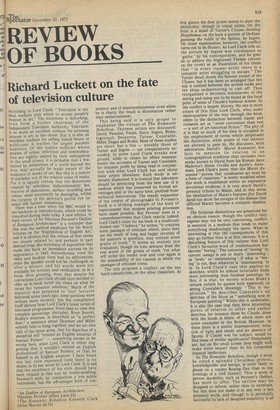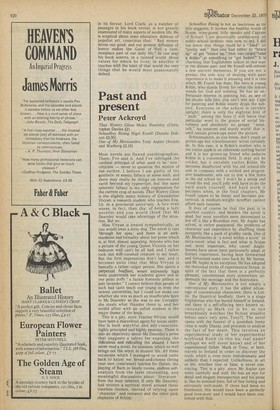REVIEW OF BOOKS
Richard Luckett on the fate of television culture
According to Lord Clark: "Television is the ideal medium with which to arouse people's interest in art." The statement is disturbing, even from a former chairman of the Independent Television Authority. Television is no doubt an excellent medium for arousing Interest in art, to the extent that it is also an excellent medium for selling baked beans or Politicians: it reaches the largest possible audience. Of the supine millions whose Powers of action, reflection and communica tion are nightly sapped by their subjugation to the small screen, it is probable that a few, stirred by intimations of a world beyond the box, may actually be made aware of the existence of works of art. But this is a matter of statistics, not of the relative value of media.
For it is equally certain that the distortions created by television, indiscriminately destructive of dimensions, surface moulding and
colour, must necessarily be damaging, whilst the tyranny of the .director's partial eye imposes still further limitations.
There was a time when the BBC would issue booklets or reproductions, which could be
consulted during radio talks. A new edition, in hard covers, of Sir Nikolaus Pevsner's Outline of European Architecture* is a reminder that this was the method employed for his Reith lectures on the 'Englishness of English Art,' and it is obvious that the virtues of that series are closely related to,. and perhaps in part derived from, the technique of exposition that made this book an immediate success on its appearance in 1943. Nevertheless, even the radio and booklet form had its deficiencies, since the speaker could not be challenged, as after a lecture, and his words were not available for scrutiny and verification, as in a book. How pleasing, then, that despite his convictions Lord Clark should have decided to offer us in book formt his views on what he terms the 'romantic rebellion.' Much of the material was prepared to 'live' lectures delivered some years ago; some portions were written more recently; but the compilation itself derives from Lord Clark's latest series of television programmes. From time to time this complex parentage obtrudes: Rose Beuret, Rodin's mistress, is described as "a perfect dear," a sentence about Daumier and Millet entirely fails to hang together, and we are also told, of the latter artist, that his depiction of a sheepfold will "remind an English amateur of Samuel Palmer" — something seems to be wrong here, since Lord Clark is either suggesting that it wouldn't remind an English professional of Samuel Palmer, or that he himself is an English amateur. I have heard this last view expressed (and there is no shame in it) but never by Lord Clark. It is sad that the excellence of his style should have been vitiated in this way by media-peddling. Pevsner's style, by comparison a less subtle instrument, has the advantages both of con
sistency and of unpretentiousness; even when he is chatty the result is illumination rather than embarrassment.
This being said it is only proper to emphasize the virtues of The Romantic Rebellion. Thirteen artists are discussed:
David, Piranesi, Fuseli, Goya, Ingres, Blake, Gqricault, Delacroix, Turner, Constable, Millet, Degas and Rodin. Most of these studies are short, but a few — notably those of Turner and Ingres — are comparatively ex tended. In some Lord Clark breaks new ground, while in others he offers reassessments: the accounts of Turner and Constable, for instance, profit by being read in conjunc tion with what Lord Clark has said about these artists elsewhere. Each study is ad mirably illustrated: it is ironical that television should be detracting from the best use of a medium which has preserved its formal ad vantages and, at the same time, profited from technical innovations. The steady expansion of the corpus of photograph's in Pevsner's book is a striking example of the kind of improvement that modern printing processes have made possible. But Pevsner aims at a comprehensiveness that Clark rejects; indeed, Lord Clark's claim for his book is a studiously modest one: "I believe," he writes, "it contains some passages of criticism which, since they are the result of long and happy scrutiny of the painters in question, may contain some grains of truth." It seems an entirely just evaluation, though its tone detracts from the real worth of the grains of truth. Yet what will strike the reader over and over again is the unsuitability of the context in which the passages of criticism come.
The title proposes a conflict: on the one hand romanticism; on the other classicism. At
first glance the dust jacket seems to state the dichotomy, though in visual terms. On the front is a detail of Turner's Ulysses deriding Polyphemus, on the back a portion of Oedipus guessing the riddle of the Sphinx, by Ingres. On closer examination, however, the conflict turns out to be illusory. As Lord Clark tells us, the picture by Ingres was condemned as ' gothic ' by his contemporaries, and he goes on to adduce the frightened Theban (shown on the cover) as an illustration of his thesis that "in every classic artist there is a romantic artist struggling to escape." The Turner detail shows the famoussunset of the Ulysses, but it has been so arranged that the sun is centred between the arched rocks and the ships endeavouring to cast off. Thus reorganized it becomes reminiscent of the setting and rising sun to be found at the focal point of some of Claude's harbour scenes. So the conflict is largely illusory. No one is more aware of this than Lord Clark, who, some three-quarters of the way through the book, refers to the distinction between classic and romantic art as "more convenient than real — a sort of art-historical fiction." The pity of it is that so much of his time is occupied in the employment of terms which perpetuate the distinction, while points of real interest are allowed to pass by. He discusses, with admiration, David's Marat Assassine, but fails to mention its relation to an iconographical tradition that includes two works known to David from his Roman days: Maderno's Santa Cecilia and Aprile's Anastasia. Lord Clark's point, that the Murat Assassine " proves that totalitarian art must be a form of classicism" is surely modified when this work is established within an expressive devotional tradition; it is very much David's personal tribute to Marat, and in this sense the idealization of Marat's features (for David dared not show the ravages of the disease that afflicted Marat) becomes a romantic idealisadon.
The fictitious distinctions are preserved for an obvious reason: though the conflict they express may not be very convincing, conflict • is essential in a medium that tends to make everything deadeningly the same. What is interesting is that the consequences of this may go further than is at first obvious. It is a disturbing feature of this volume that Lord Clark's favourite word of condemnation has become ' boring '. The converse of ' boring ' in current useage is not so much ' interesting ', as ' lively ' or ' entertaining '. If what is ' bor ing ' is out, then whatever is entertaining ' is in. In Lord Clark's case this applies to sketches, which he almost invariably finds more interesting than finished paintings. In 'this, it is true, he merely echoes Blake's remark (which he quotes with approval) on seeing Constable's drawings: "This is inspiration." He describes Constable's oil sketches of the Stour as "something new in European painting." Whilst this is undeniable, it is also the case that they have interesting points of relation to other and earlier sketches, for instance those by Claude, done with the brush in bistre, of which there are some examples in the British Museum. In these there is a similar impressionistic notation of light and shade and an absence of figures. If Claude was his subject, would he find these of similar significance? Presumably not, but on the small screen they might well make more impact than do his composed classical landscapes.
So The Romantic Rebellion, though it must be voted a splendid Christmas present, knowledgeable and benign, is more likely to please on a replete Boxing Day than in the evenings of a cold January. Then a work of proven durability, such as Pevsner's Outline, has more to offer. The outline may be designed to inform, rather than to entertain, but this does not make it in any way a less personal work, and though it is perenially successful its lack of designed popularity is all
in its favour. Lord Clark, as a number of passages in his book reveal, is not greatly enamoured of many aspects of modern life. He is sceptical about state education, dubious of populist art, conscious that: " Bad money drives out good, and our present diffusion of horror makes the Gates of Hell a commonplace part of our daily life." In one way his book asserts, in a tainted world, those values for which he lives; in another it touches with the taint of that world the very things that he would most passionately defend.



































 Previous page
Previous page